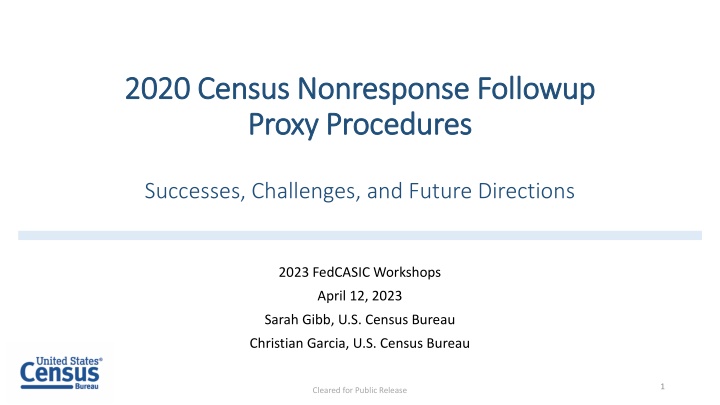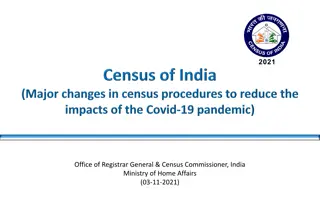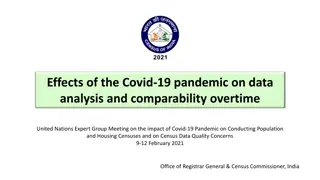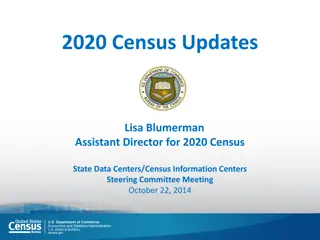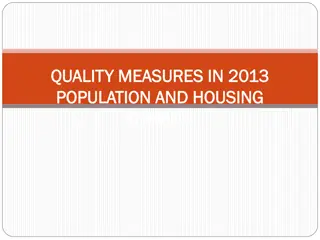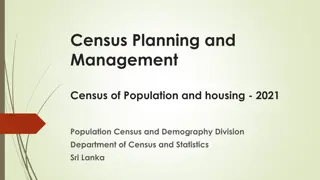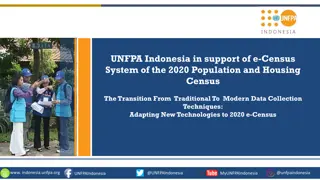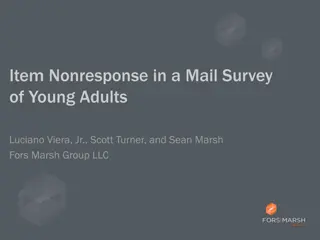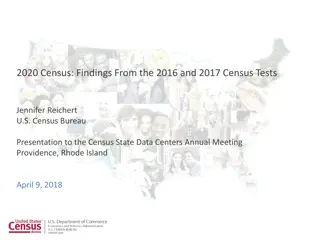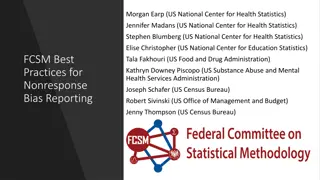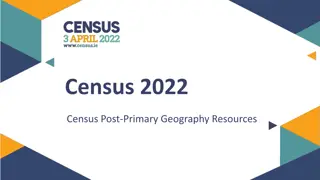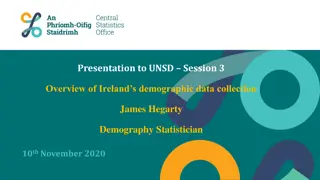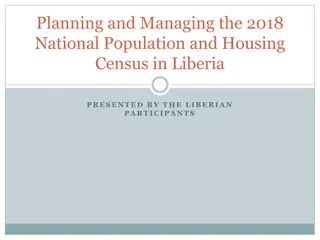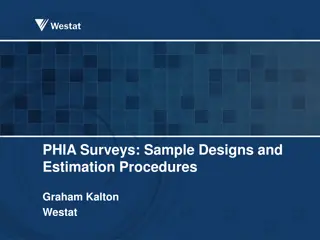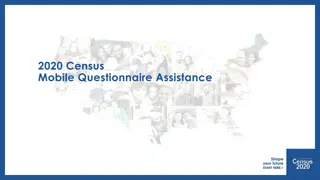Challenges and Successes in 2020 Census Nonresponse Follow-up: Insights and Recommendations
Explore the challenges faced during the 2020 Census Nonresponse Follow-up (NRFU) operation, including difficulties in proxy procedures and lessons learned. Qualitative and quantitative results shed light on the complexities encountered in enumerating households that did not complete the census questionnaire. Discover how improvements in procedures and future directions aim to address these issues for more effective census operations.
Download Presentation

Please find below an Image/Link to download the presentation.
The content on the website is provided AS IS for your information and personal use only. It may not be sold, licensed, or shared on other websites without obtaining consent from the author.If you encounter any issues during the download, it is possible that the publisher has removed the file from their server.
You are allowed to download the files provided on this website for personal or commercial use, subject to the condition that they are used lawfully. All files are the property of their respective owners.
The content on the website is provided AS IS for your information and personal use only. It may not be sold, licensed, or shared on other websites without obtaining consent from the author.
E N D
Presentation Transcript
2020 Census Nonresponse Followup 2020 Census Nonresponse Followup Proxy Procedures Proxy Procedures Successes, Challenges, and Future Directions 2023 FedCASIC Workshops April 12, 2023 Sarah Gibb, U.S. Census Bureau Christian Garcia, U.S. Census Bureau 1 Cleared for Public Release
Overview Overview Background: 2020 NRFU and Proxy Procedures Qualitative Results Quantitative Results Post-2020 NRFU Proxy Procedures Research Next Steps 2
Background: 2020 Census Nonresponse Background: 2020 Census Nonresponse Followup (NRFU) Operation Followup (NRFU) Operation Goals of NRFU operation: 1) determine housing unit status for addresses that did not complete a census questionnaire 2) enumerate people living at housing units that were occupied on April 1 (Census Day) 2020 NRFU field interviews were conducted on iPhones through an enumeration application used by census takers (enumerators) Automation allowed near real-time data capture and transfer, streamlining of enumerator work assignments and field procedures, and enhanced quality checks 3
Background: 2020 Proxy Procedures Background: 2020 Proxy Procedures Proxy respondents were people who did not live at the census address, but were knowledgeable about the housing unit status or people who lived there on April 1. The enumeration application prompted NRFU enumerators to find a proxy respondent when a household respondent was not available, typically on the third contact day. Proxy types in 2020 NRFU included: neighbors, landlords or property managers, real estate agents, relatives, caregivers, in-movers, government workers, utility workers, or the enumerator (if familiar with the household). The enumeration application required eligible cases to receive up to three proxy attempts per contact day. 4
Qualitative Results: 2020 NRFU Lessons Learned & Qualitative Results: 2020 NRFU Lessons Learned & Field Debriefing Field Debriefing The procedures for allowing enumerators to act as proxy for example, when the enumerator themselves were familiar with the nonresponding household were not clear enough. The enumeration application required three proxy attempts for eligible cases before moving to the next case. This was difficult in some situations, particularly in rural areas and gated communities, where proxies could be hard to find. Proxies often did not have the pertinent information about nonresponding households or were reluctant to provide it. 5
Quantitative Results: 2020 Item Nonresponse Rates Quantitative Results: 2020 Item Nonresponse Rates Percent Item Nonresponse of 2020 NRFU Occupied Housing Units from the Data Quality Metrics All NRFU Enumerations NRFU Household Interviews NRFU Proxy Interviews NRFU AR Enumerations Population Count <0.01% <0.01% <0.01% N/A Age or Date of Birth 24.0% 16.0% 60.8% 3.5% Hispanic Origin 16.8% 6.0% 38.1% 28.3% Race 17.5% 8.7% 41.2% 18.1% Note: Extracted from 2020 Census Data Quality Operational Metrics: Release 3, Table 2. Key takeaways: Proxies often could provide the population count associated with a nonresponding household but not demographic information about the household members. Age and date of birth were particularly difficult for proxies to provide. By comparison, these data were rarely missing from the administrative records (AR) used for enumeration. 6
Post Post- -2020 NRFU Proxy Procedures Research 2020 NRFU Proxy Procedures Research Purpose To improve the quality of proxy responses during in-field housing unit enumeration for the 2030 Census and limit respondent burden. Objectives Identify strengths and weaknesses of the proxy contact strategy and business rules for the NRFU operation during the 2020 Census. Compare the quality and completeness of data collected from proxy respondents to administrative record data. Identify ways to improve proxy data quality and procedures. Develop recommendations for updated proxy procedures, to be tested in the field and refined for the 2030 Census. 7
NRFU Proxy Procedures: Research Topics NRFU Proxy Procedures: Research Topics Rethink the workflow for cases that become eligible for proxy attempts. Make timing of proxy attempts more flexible. Revisit field procedures and quality checks for enumerators acting as proxy respondents. Investigate optimal number of proxy attempts. Collect reason when enumerator cannot complete a proxy attempt. Optimize interview content and flow for proxy respondents. 8
Proxy Research: Next Steps Proxy Research: Next Steps 1) Continue exploring improvements to future proxy procedures. 2) Translate proxy improvements into requirements for the automated enumeration application. 3) Plan for future testing of revised proxy procedures. 9
Questions or Feedback? Questions or Feedback? Sarah Gibb U.S. Census Bureau sarah.gibb@census.gov 301-763-6138 Christian Garcia U.S. Census Bureau christian.l.garcia.@census.gov 301-763-4605 10
